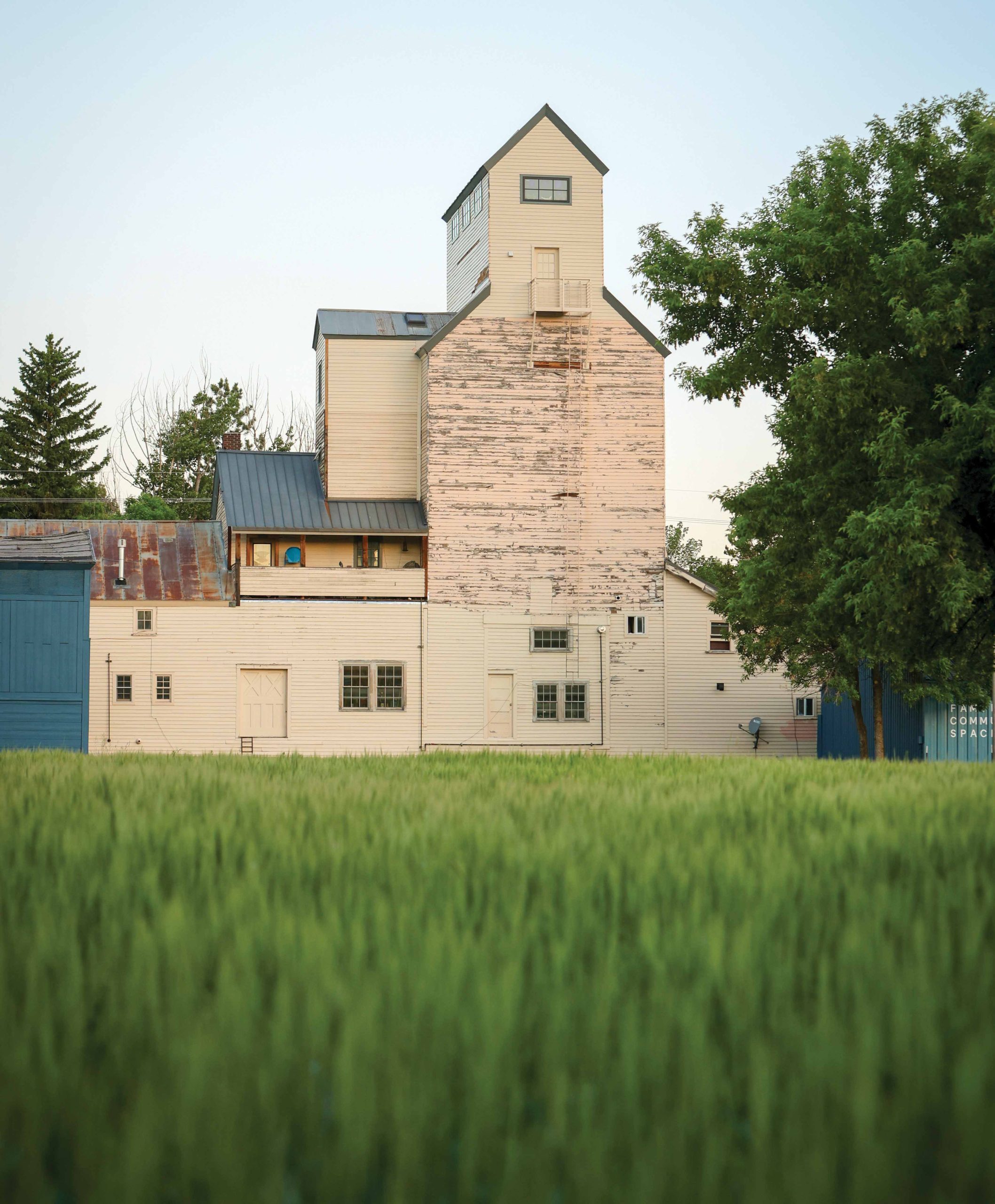
01 Aug Local Knowledge: The Energy of Things
Silt, spit, soot, wheat, and the sound of railroad ties are some of the materials at play this year at Bozeman’s Tinworks Art under the new direction of Director Jenny Moore, who assumed her role at the gallery in 2023. With an extensive curatorial background and a penchant for unique places, Moore’s vision draws from over 25 years of working with some of the most iconic artists in the country, extending the narrative for installation art spaces in Montana.
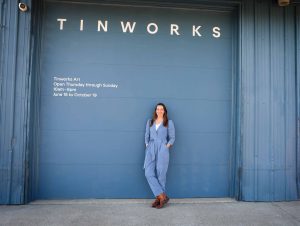
Jenny Moore, director of Tinworks Art in Bozeman, Montana, brings a myriad of curation experience — from New York City to Marfa, Texas — and hopes to elaborate on the gallery’s past installations while addressing the West’s landscapes.
“I’ve always been drawn to unconventional places,” Moore says. From 2013 to 2022, Moore was the director of The Chinati Foundation, a museum created by artist Donald Judd in Marfa, Texas. She also worked in curatorial positions at New York City’s New Museum, Andy Warhol Foundation for the Visual Arts, Exit Art, and the eighth Gwangju Biennale in South Korea.
As Tinworks Art enters its fifth year, Moore comes to it with fresh eyes and a broad perspective. “It’s a new landscape for me,” she says. “The name of this year’s exhibition is The Lay of the Land, which is how I feel getting to know Montana and the West.”
Her first project for Tinworks Art presents a major ecological artwork by Agnes Denes, Wheatfield — An Inspiration. The Seed is in the Ground. This is the first time Denes has accepted the invitation to reconsider her iconic 1982 installation Wheatfield — A Confrontation, where the artist grew a 2-acre wheat field next to the World Trade Center in New York City. This new installation in Bozeman follows Denes’ ecological investigations and encourages viewers to consider the significant role of wheat in Montana, historically, at present, and in the generations to come.
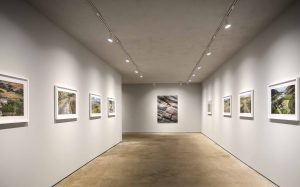
The photography of Stephen Shore lines the newly renovated interior of Tinworks Art.
This year’s installations build off of last year’s exhibition, Invisible Prairie, which featured eight artists who explored the sensory experience of the prairie landscape. These place-based installations illustrate how narratives and material objects reshape the land.
Speaking about the 2024 season, Moore says, “Many of this year’s artists come from my background, artists I knew from my own experiences. I still have so much to learn about Montana, so it was always my intention to look to those artists whose work is informed by this region, and in a response to this place and this time.”
In addition to the installations, Moore is overseeing renovations to the gallery’s interior spaces to accommodate new artwork. “Sometimes you just need a clean wall,” she laughs. The dynamics of the place reflect the context of the work being shown there. “It will be a clean slate within the prior history of the exhibition space.”
Tinworks Art is housed in an industrial building that was used as a metal shop until 2019 — hence the name “Tinworks.” With the outer metal frame still there, including a site-specific work that makes use of the tin roof with star-like holes that filter light in, the institution’s point of view continues to evolve.
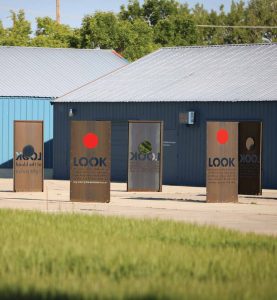
Layli Long Soldier’s piece, Day Poems: Sun Mirrors, is a site-specific installation from 2023 made from steel (with some of her poetry etched into it), mirrors, and vinyl. It welcomes guests to explore the various artworks on the property.
“I’ve always believed in connecting communities through art,” Moore says, noting how she championed the work of female artists, scholars, and professionals while director of Chinati. This included the presentation of large-scale installations by Charlotte Posenenske, Bridget Riley, and Solange. In addition, she received a significant grant from #StartSmall to provide economic and professional development opportunities for women in west Texas.
Moore lived in Marfa for 10 years. “We raised our daughters from toddlers, literally in the museum that is Chinati,” she says. “It was exhilarating and challenging in equal measure. Having completed Robert Irwin’s largest permanent art installation, a master plan, the John Chamberlain Building restoration, and the museum archive preservation — all while surviving the pandemic — I was thrilled with the opportunity to join Tinworks Art, another unique arts space at a crucial stage in its development, and help build on its beginning.”
In other words, the offer was too good to turn down. “It’s not often you get to be at the beginning of an institution, especially in a place as dynamic and inspiring as Bozeman,” Moore says. “We were up for a new adventure.”
Tinworks Art typically does not have a permanent collection, but instead offers artists the opportunity to create site- specific pieces. Some artworks stay longer than others — like Layli Long Soldier’s outdoor steel sculpture and sign on the outside of an outbuilding on the Tinworks property — but on the whole, each season is brand new.
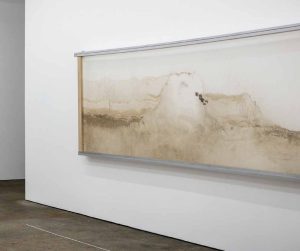
This silt-on-silk piece by Lucy Raven explores geology and place in intricate detail.
Due to a lack of central heating, Tinworks is open from summer to fall. The collection of art and artists this year explores The Lay of the Land from many angles. It’s both intimate and public, specific and universal. This year’s germinating theme springs from wild and nurtured places underfoot. It includes famed American photographer Stephen Shore’s contemplations of the landscape using his Hasselblad camera attached to a drone; ceramicist and artist-in-residence Wills Brewer, who will research the possibility of building a clay dwelling in place; Lucy Raven’s silt prints depicting the residual effects of glacial dams; and James Castle’s [1899 – 1977] soot-and-spit drawings from turn-of-the-20th-century Idaho.
Moore feels that Castle’s work represents “metaphysical depictions of the land. He makes both exterior and interior spaces feel very present and intimate.” Growing up deaf, Castle was clearly compelled to share his narrative experiences with the world. His artistic tools included found materials like sharpened sticks, apricot pits, pieces of cotton, and broken pen nibs, as well as spit and soot scraped from a wood stove. The subjects of everyday life are elevated from the mundane.
For a different take on place, sound artist Robbie Wing uses railroad ties reclaimed from the Tinworks Art site to weave together the aural world with the material landscape. “The physicality of sound can tell historical narratives,” Wing says. “I work with the idea of vibrational histories. The railroad connects many places across the U.S. — especially Montana — but those places have changed over time.”
Technically speaking, he will use the vibration of speakers and mics for feedback loops and will pull those frequencies back and through the railroad ties so they can sing their own song. It’s a piece he calls The Cross Ties Song.
While Moore finds her footing in Montana, she courageously embraces the challenge. Coming from small-town Marfa, where the main attraction was the museum, Bozeman offers a different palette, with tones and values she actively explores.
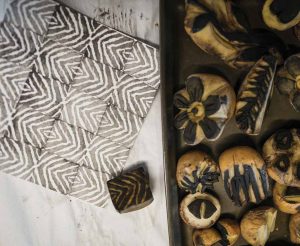
Young artists display their work in the family and community space located at the rear of Tinworks Art.
The thread of this exhibition winds through Denes’ Wheatfield, pulling together a seemingly varied set of questions surrounding land use, wrapping them through and around the historical, and tethering the entire exploration to the ramifications of that use. But, in the end, Moore’s ability to understand both the land and the artists grounds the shows in present-day concerns and subjects.
“We [as Tinworks Art] follow where the artists lead us,” Moore says. “We respond to the energy of things, and we support, encourage, and enable the artists.”
Tinworks Art’s exhibition season is free to the public and runs through October 19.
Freelance art writer, teaching professor, and author Michele Corriel earned her master’s degree in art history and her doctorate in American art. She has received a number of awards for her nonfiction, as well as her poetry. Her latest book, Montana Modernists: Shifting Perceptions of Western Art (Washington State University Press, 2022), won four awards, including a national award from the Western History Association.
Melanie Maganias loves capturing the essence of her subject matter in editorial assignments, at weddings, and in portraits by following her intuition and using her camera as a tool to depict her vision. Named one of America’s Top 15 Wedding Photographers by PDN, her work has been featured in The New York Times, Forbes, Real Simple Weddings, Martha Stewart Weddings, and many other publications. She earned bachelor’s and master’s degrees in photography and has also taught at Montana State University.




No Comments